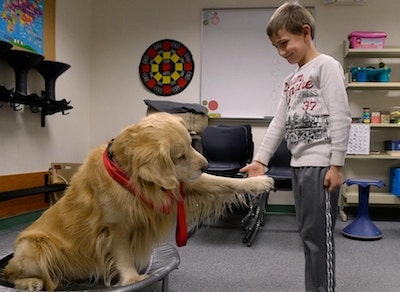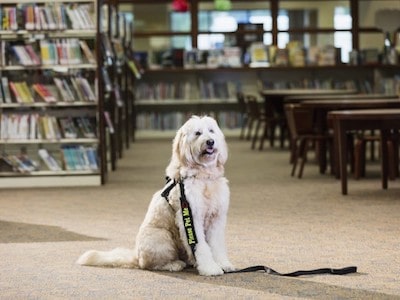Therapy dogs are extraordinary companions that provide comfort, support, and joy to individuals in a variety of settings. Whether it’s in hospitals, nursing homes, schools, or disaster areas, therapy dogs have the incredible ability to bring smiles to people’s faces and provide much-needed emotional support. But what does it take to transform a regular dog into a therapy dog? That’s where therapy dog training comes into play.
Therapy dog training is a specialized form of obedience training that focuses on preparing dogs to interact with people in a therapeutic setting. It goes beyond basic obedience commands and delves into the intricacies of socialization, emotional support, and stress relief.

Through a combination of training techniques and positive reinforcement, therapy dog training helps dogs develop the skills and temperament necessary to excel in their role as therapy dogs.
In this comprehensive guide, we will explore the world of therapy dog training and provide you with valuable information on how to find the best training programs near you. We will also discuss the benefits of therapy dogs, the training process, and answer some frequently asked questions to help you navigate this rewarding journey.
So, whether you are a dog lover interested in getting involved in therapy work or an organization seeking to enhance your therapy dog program, this article is your go-to resource for all things therapy dog training. Let’s dive in and discover the incredible world of therapy dogs together!
Benefits of Therapy Dogs
Therapy dogs play a vital role in enhancing the well-being of individuals in need. These incredible canines have been specially trained to provide a range of benefits, including emotional support, physical assistance, and stress relief. Let’s delve into each of these advantages in more detail.
Emotional Support
One of the most significant benefits of therapy dogs is their ability to provide emotional support. These compassionate animals have a unique gift for connecting with people on a deep, empathetic level.
Whether it’s a child struggling with anxiety, a veteran coping with PTSD, or an elderly individual experiencing loneliness, therapy dogs have an innate ability to offer comfort and companionship.
Through their gentle presence and unconditional love, therapy dogs can help reduce feelings of stress, anxiety, and depression, promoting a sense of calm and emotional well-being.
Physical Assistance
Therapy dogs are not only skilled in providing emotional support but can also offer valuable physical assistance. For individuals with physical disabilities or limited mobility, these specially trained companions can be a lifeline.
Therapy dogs can be trained to perform tasks such as retrieving dropped items, opening doors, or even assisting with balance and stability.
Their presence enables individuals to navigate their daily lives more independently, enhancing their overall quality of life.

Stress Relief
In today’s fast-paced and demanding world, stress has become a common part of many people’s lives. However, therapy dogs have the remarkable ability to alleviate stress and promote relaxation.
Interacting with a therapy dog has been shown to lower blood pressure, reduce heart rate, and release endorphins – the body’s natural stress-fighting hormones.
Whether it’s through stroking their soft fur, engaging in playtime, or simply being present, therapy dogs have a remarkable calming effect on individuals, helping them unwind and find solace in their company.
The benefits of therapy dogs are truly remarkable, offering a range of emotional support, physical assistance, and stress relief. If you or someone you know could benefit from the incredible bond that therapy dogs provide, it’s essential to explore the available training options in your area. In the next section, we will dive into how to find therapy dog training near you, ensuring that you can connect with the perfect program to meet your needs.
Finding Therapy Dog Training Near You
When it comes to finding the perfect therapy dog training for your furry friend, it’s essential to do your homework. Researching and selecting the right training center can make all the difference in your dog’s development as a therapy dog. Here are some key steps to help you find therapy dog training near you:
Research Local Training Centers
Start by researching local training centers in your area. A quick online search or asking for recommendations from friends, family, or your veterinarian can yield a list of potential options. Dog training centers, puppy training classes, and service dog training programs are all great places to start your search.
Read Reviews and Testimonials
Once you have a list of potential training centers, take the time to read reviews and testimonials from previous clients. Hearing about other people’s experiences can give you valuable insight into the quality of the training program. Look for reviews that highlight positive outcomes, knowledgeable trainers, and a supportive learning environment.

Consider Training Methods and Approaches
Every training center has its own unique methods and approaches to therapy dog training. Some may focus on positive reinforcement techniques like clicker training for dogs, while others may emphasize agility training or leash training. Consider what training methods align with your dog’s personality and your training goals.
Check Certification and Accreditation
When looking for therapy dog training, it’s important to choose a center that is certified and accredited. This ensures that the trainers have undergone proper education and have met certain standards in the field. Look for certifications such as the Canine Good Citizen (CGC) or Therapy Dogs International (TDI). Checking for accreditation gives you peace of mind that you are selecting a reputable and reliable training program.
By following these steps and conducting thorough research, you can find the right therapy dog training near you. Remember, each dog is unique, so it’s essential to choose a program that suits your dog’s temperament and your training goals. Take the time to evaluate different options and consult with trainers to ensure you make the best choice for your beloved pet.
Choosing the Right Training Program
When embarking on the journey of therapy dog training, it is crucial to select the right program that suits both you and your furry companion. With the abundance of options available, it can be overwhelming to make a decision. However, by considering a few key factors, you can ensure that you find the perfect fit for your dog’s needs.
Assess Your Dog’s Temperament and Skills
Every dog is unique, and it is essential to assess your dog’s temperament and skills before enrolling them in a therapy dog training program. Some dogs may naturally possess the qualities required for therapy work, such as being calm, friendly, and gentle. Others may need a bit more guidance and socialization to develop these traits.
Take the time to observe your dog’s behavior in various situations. Are they comfortable around new people and other animals? Do they remain calm in unfamiliar environments? Assessing your dog’s temperament will help you determine the training approach that suits them best.
Consult with Trainers
Seeking guidance from experienced trainers can provide valuable insights into the training process. They have the expertise to evaluate your dog’s potential for therapy work and can offer personalized advice based on their observations.
Reach out to trainers who specialize in therapy dog training or have experience working with therapy dogs. Private dog trainers near me can provide individual attention and tailor the training program to your dog’s specific needs. Consulting with these professionals will help you gain a better understanding of the training requirements and expectations.

Evaluate Training Curriculum and Duration
When selecting a training program, it is crucial to evaluate the curriculum and duration of the program. Look for programs that cover essential obedience training, socialization skills, and specific therapy dog training techniques. Clicker training for dogs and agility training for dogs are often incorporated into therapy dog training to enhance the dog’s skills and responsiveness.
Consider the duration of the program as well. Some programs may be more intensive and require a longer time commitment, while others may offer a more flexible schedule. Assess your availability and your dog’s ability to handle longer training sessions to find a program that aligns with your needs.
Consider Cost and Location
Cost and location are practical factors to consider when choosing a training program. Research the pricing structure of different programs and evaluate whether they fit within your budget. Keep in mind that therapy dog training is an investment in your dog’s well-being and the impact they will have on others.
Additionally, consider the location of the training facility. Opting for a program that is conveniently located near your home or workplace will make it easier for you to attend training sessions regularly and ensure consistency in your dog’s training.
By carefully assessing your dog’s temperament, consulting with trainers, evaluating training curriculum and duration, and considering cost and location, you can confidently choose the right training program for your therapy dog journey. Remember, finding the perfect fit will set the foundation for a successful and rewarding partnership with your four-legged companion.
Training Process and Requirements
Once you have selected a therapy dog training program, it’s important to understand the training process and the requirements involved. This section will outline the key elements of therapy dog training, including basic obedience training, socialization skills, and therapy dog certification.
Basic Obedience Training
Before diving into therapy dog training, it’s essential to ensure that your furry companion has a solid foundation in basic obedience. This includes commands such as “sit,” “stay,” “down,” and “come.” Basic obedience training establishes a line of communication between you and your dog, enabling you to effectively guide them during therapy sessions.
During basic obedience training, you will work on reinforcing positive behaviors and discouraging negative ones. This can be achieved through the use of positive reinforcement techniques, which involve rewarding your dog with treats, praise, or playtime when they exhibit desired behaviors. For example, if your dog sits when commanded, you can reward them with a treat and verbal praise.
To enhance the training experience, you may also consider using clicker training for dogs. This method involves using a clicker to mark the desired behavior, followed by a reward. The clicker serves as a signal to your dog that they have performed the desired action correctly.
Socialization Skills
Socialization is a vital aspect of therapy dog training. It involves exposing your dog to various environments, people, and other animals to ensure they are comfortable and well-behaved in different situations. Socialization helps therapy dogs develop the confidence and adaptability required to interact with individuals they will encounter during therapy sessions.
To effectively socialize your dog, consider enrolling them in puppy training classes or dog obedience classes near you. These classes provide opportunities for your dog to interact with other dogs and people in a controlled environment, under the guidance of professional trainers. Additionally, you can organize playdates with other friendly and well-behaved dogs to expose your dog to different social scenarios.

Therapy Dog Certification
Once your dog has completed the necessary training, you can pursue therapy dog certification to officially validate their abilities as a therapy dog. Certification requirements may vary depending on the organization or program you choose, but generally involve an assessment of your dog’s temperament, behavior, and obedience skills.
Certification programs typically include an evaluation conducted by a certified evaluator. This evaluation assesses your dog’s ability to remain calm and well-behaved in various situations, their response to different stimuli, and their interaction with individuals of diverse ages and backgrounds.
It’s important to note that therapy dog certification is not mandatory in all cases. Some organizations may accept dogs without formal certification, as long as they meet specific criteria and demonstrate the necessary qualities to be a therapy dog. However, obtaining certification can enhance your dog’s credibility and increase opportunities for involvement in therapy work.
Remember, the training process and requirements for therapy dog training may differ based on the organization or program you choose. It’s crucial to thoroughly research and consult with trainers or professionals in the field to ensure you’re following the appropriate guidelines and protocols.
In the next section, we will address frequently asked questions about therapy dog training, including whether any dog can become a therapy dog, the typical duration of therapy dog training, and the associated costs. Stay tuned!
Recommended articles:
Frequently Asked Questions
As you embark on the journey of therapy dog training, you may have a few questions swirling in your mind. Don’t worry, we’ve got you covered! Here are some of the most commonly asked questions about therapy dog training:
Absolutely! While certain breeds are often associated with therapy work, such as Golden Retrievers and Labrador Retrievers, any dog can potentially become a therapy dog. What matters most is the dog’s temperament, behavior, and willingness to interact with people in a calm and gentle manner. Whether your furry friend is a small Chihuahua, a playful Terrier, or a majestic Great Dane, they can all make a positive impact as therapy dogs.
If you’re uncertain about your dog’s suitability for therapy work, it’s a good idea to consult with a professional trainer or an organization that specializes in therapy dog training. They can evaluate your dog’s temperament and provide guidance on whether they have the potential to become a therapy dog.
The duration of therapy dog training can vary depending on several factors, including the dog’s age, previous training experience, and the specific training program you choose. On average, therapy dog training can take anywhere from several months to a year.
It’s important to remember that therapy dog training is not a one-time event but an ongoing process. It involves teaching your dog specific skills and behaviors, as well as providing ample opportunities for socialization and exposure to various environments. Consistency, patience, and positive reinforcement are key elements in the training journey.
The costs associated with therapy dog training can vary depending on several factors, such as the location, the training program, and any additional services or certifications included. It’s best to research and compare different training centers or private trainers in your area to get an idea of the average costs.
In general, therapy dog training can range from a few hundred dollars to a few thousand dollars. This may include expenses such as training classes, private sessions, training equipment, and any required certifications or assessments. Keep in mind that the investment you make in therapy dog training is not only for your dog’s benefit but also for the positive impact they will have on the lives of others.
Before enrolling in a training program, it’s important to consider your budget and choose a program that aligns with your financial capabilities. Additionally, some organizations may offer financial assistance or scholarships for therapy dog training, so it’s worth exploring those options as well.
Remember, therapy dog training is a fulfilling and rewarding experience that not only strengthens the bond between you and your furry companion but also brings comfort and joy to those in need. So, take the leap and embark on this beautiful journey of spreading love and healing through the power of therapy dogs!
If you’re interested in learning more about other types of dog training, such as puppy training near me, service dog training near me, or even clicker training for dogs, be sure to explore our website for valuable resources and information.
Conclusion
In conclusion, therapy dog training is an invaluable investment for both dogs and their owners. The benefits of having a therapy dog are wide-ranging and can greatly enhance the lives of those in need. These dogs offer emotional support, physical assistance, and stress relief, making them indispensable in various settings such as hospitals, nursing homes, and schools.
When it comes to finding therapy dog training near you, it’s important to conduct thorough research. Look for local training centers that specialize in therapy dog training, and take the time to read reviews and testimonials from previous clients. Consider the training methods and approaches used by the center, as well as their certification and accreditation.
Once you’ve narrowed down your options, it’s crucial to choose the right training program for your dog. Assess your dog’s temperament and skills, and consult with trainers to determine the best fit. Evaluate the training curriculum and duration to ensure it aligns with your goals, and also consider factors such as cost and location.
During the training process, your dog will undergo basic obedience training and develop essential socialization skills. These are crucial foundations for becoming a therapy dog. It’s also important to note that therapy dog certification is typically required to ensure the dog meets the necessary standards and qualifications.
To address some common questions, not all dogs can become therapy dogs. Temperament, behavior, and health play a significant role in determining suitability. The duration of therapy dog training varies, but it typically takes several months to a year to complete. As for costs, they can vary depending on the training program and location.
In summary, therapy dog training is a rewarding journey that can positively impact the lives of both dogs and the people they serve. By investing time, effort, and resources into finding the right training program, you can help your dog become a well-trained and certified therapy dog. So, take the first step towards this meaningful endeavor and explore the options available to you.
For more information on other types of dog training, such as puppy training, service dog training, clicker training for dogs, agility training for dogs, leash training for dogs, behavior training for dogs, dog obedience classes, or private dog trainers, visit our website. Additionally, if you need assistance with crate training or dog training for separation anxiety, our team of experts is here to help you and your furry friend on your training journey.

Ellis is a retired veterinary technician and full-time contributor at DogLovesBest. He likes writing about pet health care tips and reviews the products that are useful for fidos on a daily basis.
Ellis also guardians a Siberian husky, Nova, and a cat named Shilly. They all live happily with his wife Ammy, and both the dogs on a seaside apartment in Queens, NY.
